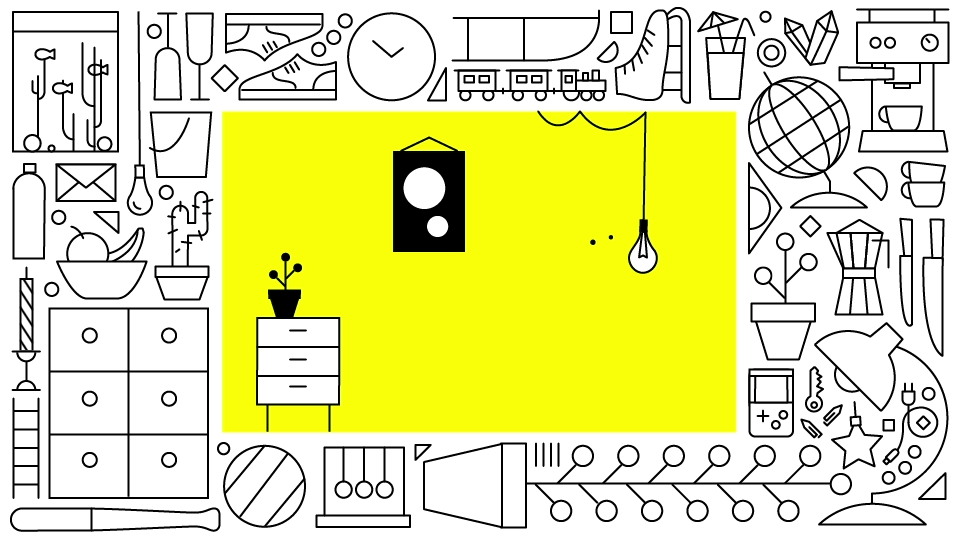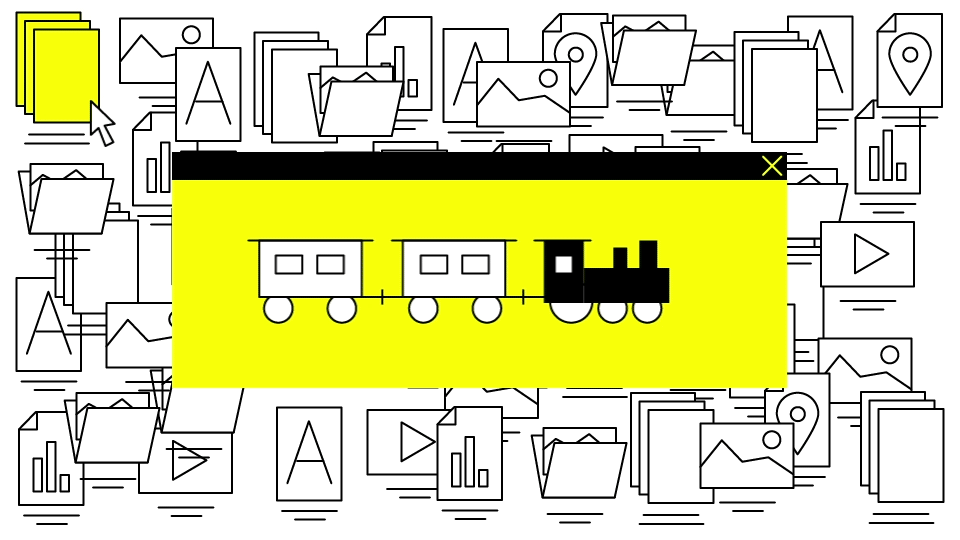Oliver Herwig • 18.09.2018
Obsession and order
Possessions are a burden – that’s the diagnosis by sociologists and psychotherapists. But what can we do when we accumulate an increasing number of things? A ramble through under-bed drawers and lever-arch files, storage boxes and self-storage units. Via the meaning of classification systems.
Skis without bindings are stored in the garage, next to pots of half-empty wall paint and magazines. In the cellar grandma’s preserving jars, vacuum cleaner bags and old electric toothbrushes are gathering dust, while Christmas baubles, decorations and tinsel are lurking in the cupboard – enough for five to seven sparkling Christmas trees. It doesn’t have to be abnormal, but it may be questionable. In Germany alone an estimated 1.8 million people suffer from “Messy syndrome”, as reported by «Ärzteblatt» in September 2002. Their everyday lives are governed by disorganisation and «inner chaos, which shows itself externally.» Sounds like lost hunters and collectors. In the past an inclination to hoard things helped to get people through difficult times and build up what we call civilisation. Now the things we use for our lives have become a problem. There are simply too many of them. This means we must keep things tidy. There’s a wall holder for every toothbrush, the correct insert for every spanner in the toolbox, which in turn fits precisely into the niche in the tool cupboard.
It’s hard work keeping things tidy because things are not sat on or laid on, but just kept. We are all battling the hamster in us. The design legend Dieter Rams already advised his followers to thin out the chaos around them. This is because we are increasingly collecting more things, often for no reason. There are homes through which the inhabitants can walk only along a path wedged between all the things that they might perhaps need one day. We are all affected by hoarding. Anyone who moved home at the age of 20 with their bicycle or with an estate car, is guaranteed to need a furniture van ten years later and after another ten years will need a team of professionals to wrap the breakable porcelain in tissue paper and swear on every step about the piano, which no one has played for years.
There seems to be a basic principle: Things attract more things.
A fountain pen needs cartridges or an inkwell, in the past also blotting paper and of course a case. The mobile phone needs a case, portable charger and headphones. And if something does become obsolete as a result of technical developments – a charging cable for example –, the functions return via the back door, perhaps as a charging point.
The things for life
«Excess and surplus are relative. There is no fixed line separating requirements and wishes.»
Accumulating possessions is relatively new in human history. Anyone who visits old farmhouses, often finds only a niche in the corridor. This is where the most important things were kept. No shelf or storage rack. The hole in the wall was enough for keys and a petroleum lamp. There was a hook for clothing and anyone who was rich, could even afford storage chests. Even just 100 years ago, a household might have had perhaps 200 things. In the meantime it’s 50 times as many – approximately 10,000 items. And yet many things don’t have the same significance as previously. The Sunday crockery was displayed on dressers to show culture, but above all the social status of the host. Then came the wall unit with shelves for this and that. Today a plasma screen, half as wide as the wall, is sufficient. This has the advantage that one can also sweep up the last few books and digitalise them. Things have become a matter of course. One just has them. Or perhaps no longer (visibly). But however much we share and de-clutter, things still have to be tidy. However, visible chaos sometimes also generates the opposite – a spartan living environment. The more messies and preppers (who store corned beef, beans and rice by the palette, plus batteries, radio equipment, protective vests and tools, to be equipped for the major catastrophe), the more organised living ascetics and fanatics for tidiness.
But going back to the surplus again, which partly arises from a differentiated society and highly equipped industry that develops the right clothing for every type of sport. There’s a top for the fitness studio, for cycling, for yoga and another one for Pilates. We are experiencing an explosion of equipment for our own bodies. And with regard to cars, it’s expressed in ever weightier models. The Golf from 1974 weighed about 750 kilograms, today it’s almost a ton and a half. Frank Trentmann, who lectures as a Professor of history at Birbeck College at the University of London, calls it the «domination of things». The researcher into everyday life and consumption believes: «Excess and surplus are relative. There is no fixed line separating requirements and wishes.» First one needs to eat, then comes the Tiffany lamp, is how Maslow’s hierarchy of needs (pyramid of needs), published in “the Psychologist” in 1943, could be abbreviated. «When a need is satisfied, then another one arises», wrote Abraham Maslow. Are we therefore also accumulating things, which are intended to facilitate our lives and then swamp entire homes like quicksand? Trying to regain control of this flood becomes a real challenge.
Live and let store
When a home overflowed, he simply locked it up and moved into a new one.
Luckily there is self-storage. Once again a word that pretty well describes how we live today and arrange for things be stored. We simply pack our things away and rent containers on the outskirts of towns. Out of sight, out of mind. The supply of external storage space ranges from one to 100 square metres and the units are up to three metres high. Professionals have a rule of thumb: The storage space must be ten to 15 percent of the size of the home. This equates to removing all the air between things and sticking boxes on a chair on the sofa right up to the ceiling. 100 square metres of home is squashed into ten to 15 square metres of storage space. Is this really worthwhile? In the countryside perhaps not, but in towns where homes with a larder and large cellar are in short supply, many people use an external storage space as an «extended living room», quotes Christian Lohmann, the MD, to the members of the board of the Verband Deutscher Self Storage Unternehmen e.V. (VdS). Self-storage containers can be found near major arterial roads and are organised in such a way that one telephones, drives up with the car, signs the contract and stores one’s things the very same day. With one’s own access code and chip card, the warehouses are open round the clock. Start-ups even offer an all-round service and collect the boxes from home. As a reminder of all the things that vanish from view, the providers offer apps, in which one can upload one’s belongings as photos. Perhaps one could even make a photo album of them, but where would one put it?
Critics will mention that a clever business model is making money here out of our inclination to hoard. But that all depends on the perspective. Anyone who should actually move because he doesn’t want to also put his ski equipment in the wardrobe, will find self-storage to be a clever alternative, but anyone who accumulates and accumulates things, is just shifting the problem elsewhere. But don’t worry. We are in good company. Allegedly Picasso was also a passionate collector. When a home overflowed, he simply locked it up and moved into a new one. Admittedly that’s a luxury solution.
Anyone who still has too many things after various clear-outs, which flutter through the home abandoned, should – paradoxically – go shopping and buy new things. Namely classification systems. In any case, online shops and furniture stores are jumping on the bandwagon: There are boxes, wardrobes, clothes racks, baskets, shelves, umbrella stands, key boxes, shoe racks, chests, under-bed cupboards and newspaper racks. Unfortunately there are no statistics about how great the relationship is between the little helpers to the things that they are intended to sort, but a classification system should probably cater for dozens of things. Naturally the «lever-arch file» is unbeatable – front and back covered in marbled paper, corners and grip hole made of reinforced steel and a metal lever. Together with the spine label and duct tape – the epitome of compression through tidiness.
Everything in order?
«Not needing anything is godly, needling as little as possible, is as close to godly completeness as possible.»
What does this collecting, keeping and space-saving storage actually say about our society? Above all, that we are in turmoil. We require more resources, space and energy than previous generations – and are slowly reaching the limits of what is possible. Homes are no longer expanding at the same pace. When looking at metropolises such as Tokyo, London, Zurich and Munich, there is the suspicion that storage is not only an expression of excess, but also a need, because one wants to store one’s possessions in as little space as possible. Social codes have changed during this process. What we regard as too much, can be the expression of wealth and social status in other cultural circles. In India one carries one’s status on one’s wrist in the form of gold chains. On the other hand we have mobile phones with exotic holiday photos, functional clothing and sometimes even cars.
Recently a counter-movement is establishing itself against excessive consumption. Less, but more consciously. Sharing instead of buying. Detoxifying and finding oneself and one’s own submerged requirements. This is what some theories say. Even Socrates had something to say about this: «Not needing anything is godly, needling as little as possible, is as close to godly completeness as possible.» 2,400 years later Werner Tiki Küstenmacher and Lothar J. Seiwert made a best-seller «simplify your life – living more simply and more happily» out of this and launched a small simplification universe of books, calendars and self-help. The comfortable thing about this? Even simple things push for involvement and – unfortunately one has to say it: complexity. It’s not yet been decided where the «domination of things» will really lead. Anyone who does not tend towards dystopia, must inevitably limit themselves. Office worlds show the way – concepts such as the «clean desk policy» ensure brutal tidiness. Anyone who shares a desk or even no longer has their own one, is dependent on everyone clearing up all the notepads, pens and notes in the evening and handing over the workspace in a tidy condition. Simplify your work also applies to our lives. We can’t get away from de-cluttering, detoxifying, handing over and sharing. And when we can’t cope any more, then there are still solutions to dispose of our growing excess: Bags and drawstring bags, containers for used glass
Illustration: Josh Schaub


